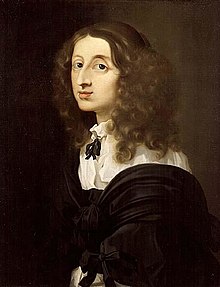| Christina | |||||
|---|---|---|---|---|---|
 | |||||
| Queen of Sweden | |||||
| Reign | 16 November [O.S. 6 November] 1632 – 16 June [O.S. 6 June] 1654 | ||||
| Coronation | 20 October 1650 | ||||
| Predecessor | Gustav II Adolf | ||||
| Successor | Charles X Gustav | ||||
| Regent | Axel Oxenstierna (1632–1644) | ||||
| Born | 18 December [O.S. 8 December] 1626 Tre Kronor Castle, Stockholm, Sweden | ||||
| Died | 19 April 1689 (aged 62) Rome, Papal States | ||||
| Burial | 22 June 1689 St. Peter's Basilica, Vatican City | ||||
| |||||
| House | Vasa | ||||
| Father | Gustav II Adolf of Sweden | ||||
| Mother | Maria Eleonora of Brandenburg | ||||
| Religion | Lutheran (1626–1654) Catholic (1654–1689) | ||||
| Signature | |||||
Christina (Swedish: Kristina; 18 December [O.S. 8 December] 1626 – 19 April 1689) was a member of the House of Vasa and the Queen of Sweden in her own right from 1632 until her abdication in 1654.[a] Her conversion to Catholicism and refusal to marry led her to relinquish her throne and move to Rome.[7]
The Swedish queen is remembered as one of the most erudite women of the 17th century, wanting Stockholm to become the "Athens of the North"[8] and was given the special right to establish a university at will by the Peace of Westphalia.[9] She is also remembered for her unconventional lifestyle and occasional adoption of masculine attire, which have been depicted frequently in media; gender and cultural identity are pivotal themes in many of her biographies.[10]
She succeeded her father Gustavus Adolphus upon his death at the Battle of Lützen at seven years old, but she began ruling the Swedish Empire when she reached the age of eighteen.[11] During the Torstenson War in 1644, she initiated the issuance of copper in lumps to be used as currency. Her lavish spending habits pushed the state towards bankruptcy, sparking public unrest. Christina argued for peace to end the Thirty Years' War and received indemnity. Following scandals over her not marrying and converting to Catholicism, she relinquished the throne to her cousin Charles X Gustav and settled in Rome.[12]
Pope Alexander VII described Christina as "a queen without a realm, a Christian without faith, and a woman without shame."[7] She played a leading part in the theatrical and musical communities and protected many Baroque artists, composers, and musicians. Christina, who was the guest of five consecutive popes[13] and a symbol of the Counter-Reformation, is one of the few women buried in the Vatican Grottoes.
- ^ Popp, Nathan Alan (2010). Beneath the surface: The portraiture and visual rhetoric of Sweden's Queen Christina (MA thesis). University of Iowa. doi:10.17077/etd.8ii490wt.
- ^ J. Guinchard (1914). Sweden: Historical and statistical handbook. Stockholm: P. A. Norstedt & Söner. p. 188.
- ^ Stefan Donecker/Roland Steinacher (2009) Der König der Schweden, Goten und Vandalen. Königstitulatur und Vandalenrezeption im frühneuzeitlichen Schweden. In: Vergangenheit und Vergegenwärtigung. Frühes Mittelalter und europäische Erinnerungskultur. Ed. by Helmut Reimitz and Bernhard Zeller (= Forschungen zur Geschichte des Mittelalters 14; Wien 2009).
- ^ Stolpe 1974 pp. 142 & 145
- ^ Stefan Donecker/Roland Steinacher, Rex Vandalorum. The Debates on Wends and Vandals in Swedish Humanism as an Indicator for Early Modern Patterns of Ethnic Perception. In: Der Norden im Ausland – das Ausland im Norden. Formung und Transformation von Konzepten und Bildern des Anderen vom Mittelalter bis heute, ed. Sven Hakon Rossel (Wiener Studien zur Skandinavistik 15, Wien 2006) 242–252
- ^ A Journal of the Swedish Embassy in the Years 1653 and 1654, Vol II. by Whitlocke. 28 December 2005. Retrieved 10 July 2017 – via Project Gutenberg.
- ^ a b Lindsay, Ivan (2 June 2014). The History of Loot and Stolen Art: from Antiquity until the Present Day. Andrews UK Limited. ISBN 9781906509576. Retrieved 10 July 2017 – via Google Books.
- ^ Hoskin, Dawn (18 December 2014). "Born on This Day: Queen Christina of Sweden". The V&A. Victoria and Albert Museum.
- ^ "Instrumentum Pacis Osnabrugensis". 25 March 2014.
- ^ Zimmermann, Christian von (10 July 2017). Frauenbiographik: Lebensbeschreibungen und Porträts. Gunter Narr Verlag. ISBN 9783823361626. Retrieved 10 July 2017 – via Google Books.
- ^ "Sweden". World Statesmen. Retrieved 19 January 2015.
- ^ Script from Clark.edu by Anita L. Fisher Archived 2015-04-02 at the Wayback Machine
- ^ Hofmann, Paul (8 October 2002). The Vatican's Women: Female Influence at the Holy See. St. Martin's Press. p. 42. ISBN 9781429975476. Retrieved 10 July 2017 – via Internet Archive.
Cite error: There are <ref group=lower-alpha> tags or {{efn}} templates on this page, but the references will not show without a {{reflist|group=lower-alpha}} template or {{notelist}} template (see the help page).